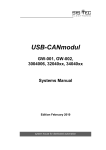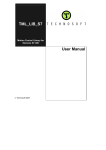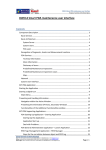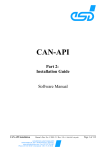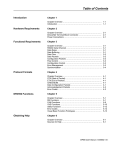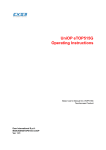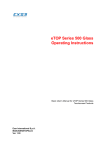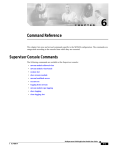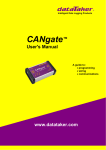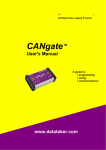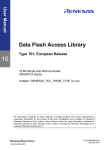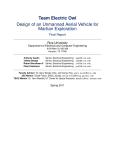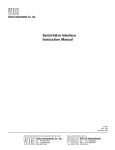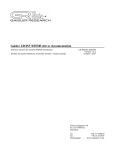Download User Manual
Transcript
JetBox 8152 Linux CANBus
User Manual
www.korenix.com
Copyright Notice
Copyright© 2012 Korenix Technology Co., Ltd.
All rights reserved.
Reproduction without permission is prohibited.
Information provided in this manual is intended to be accurate and reliable.
However, the original manufacturer assumes no responsibility for its use, or for
any infringements upon the rights of third parties that may result from its use.
The material in this document is for product information only and is subject to
change without notice. While reasonable efforts have been made in the
preparation of this document to assure its accuracy, Korenix assumes no liabilities
resulting from errors or omissions in this document, or from the use of the
information contained herein.
Korenix reserves the right to make changes in the product design without notice
to its users.
Acknowledgments
Korenix is a registered trademark of Korenix Technology Co., Ltd.
All other trademarks or registered marks in the manual belong to their respective
manufacturers.
Korenix | Table of Content
2
Table of Content
Copyright Notice ............................................................................................2
Acknowledgments..........................................................................................2
Table of Content.............................................................................................................3
Chapter 1 Introduction ...............................................................................................4
Chapter 2 Hardware Configuration.............................................................................6
2-1
Pin Assignment...........................................................................................6
2-2
Chapter 3
3-1
Jumper Setting: JP6....................................................................................6
Software Configuration ..............................................................................7
Installation..................................................................................................7
3-2
Chapter 4
4-1
4-2
Example......................................................................................................8
Korenix Library Reference ..........................................................................9
How to Use Library.....................................................................................9
Functions....................................................................................................9
4-3
Chapter 5
5-1
5-2
Structure ..................................................................................................15
Appendix ..................................................................................................17
Baud Rate Table........................................................................................17
Error Code Table.......................................................................................18
5-3
5-4
5-5
Notes ........................................................................................................19
Revision history ........................................................................................20
Customer Service .....................................................................................20
Korenix | Table of Content
3
Chapter 1 Introduction
The JetBox 8152 has two ports for I/O communications, One RS-232/422/485 port and
one CANBUS port. The CAN (Controller Area Network) is a serial bus system
especially suited for networking "intelligent" I/O devices as well as sensors and
actuators within a machine or plant. Characterized by its multi-master protocol,
real-time capability, error correction, high noise immunity, and the existence of many
different silicon components, the CAN serial bus system, originally developed by
Bosch for use in automobiles, is increasingly being used in industrial automation.
CANbus
This section describes how to program and use the CANBUS. It provides a description
of the I/O memory map of the chip and discussion of the internal registers to aid you
in programming your CAN controller chip.
Defined Memory Mapping and Interrupt
The CANBUS occupies 2 bytes of memory space. You can set the base address and
access to the internal resources of the SJA1000 CAN controller chip. The SJA1000
chip access is multiplexed in such a way that the host must first write to 300h the
internal address of the CAN chip and after that perform a write to address 301h with
the actual data to be written into the desired memory location. Address 302h is a
hardware-reset function of the SJA1000. Performing a read or write to this address
Korenix | Introduction
4
will cause a hardware reset to the CAN controller. You may need to reset the chip in
case of an unrecoverable error in the CAN controller chip. And your can use interrupt
the main processor when a message is received or transmitted if interrupts are
enabled on the JetBox 8152. By using interrupts you can write powerful code to CAN.
Description
Factory Setting
Base Address
300H
Data Of Address
301H
Hardware Reset Of SJA1000 Chips
302H
Interrupt Require Quest
11
Example Programming
Write 300H to the CAN controller Control byte located in the on-chip address 0.
The Example is listed below:
Outportb (0x300, 0x00) : Write CAN Address 0 (Control Register )
Outportb (0x301, 0x78) : Write Data of CAN Address 0 (Control Register )
And please see “SJA1000.pdf” for further information of the SJA1000 chip.
Korenix | Introduction
5
Chapter 2 Hardware Configuration
2-1
Pin Assignment
The CANBUS is use DB9 standard connector. The following tables show the
CANBUS signal connections of this connector.
DB-9
CANBUS
1
6
2
7
3
8
4
9
5
Case
CANBUS
Signal
N.C
N.C
CAN-L
CAN-H
CAN-Ground
N.C
N.C
N.C
Ground
Case Ground
CANBUS
Description
Dominant Low
Dominant High
Isolated Ground
Digital Ground
Note 1: The CANBUS DB9-pin out conforms to the ISO 11898/2 standard
2-2
Jumper Setting: JP6
JP6: CANBUS Terminal Resistor Selection
Factory preset
Note 2: The JP6 is the CANbus termination jumper. Only two termination
jumpers should be closed at the endpoints of the CANbus. Value Terminator Resistor
(120 Ω). The minimum speed is 20k bps. The maximum speed is 1M bps. But when
CANBUS terminator is disabled, the maximize speed of CANBUS is 125k bps. If you
want to use high speed (1M bps), please enable terminator.
Korenix | Hardware Configuration
6
Chapter 3 Software Configuration
3-1
Installation
Prerequisites
To make CANBus work correctly. We have to install three components first.
Make sure your network is connected.
1. GCC : call “yum install gcc”
2. OpenSSL : call “yum install openssl”
3. OpenSSL-devel : call “yum install openssl-devel.i386”
After install these components, the CANBUS library and follow example code
will work successfully.
Do the following steps to setup the driver
1. Login in as root. ( username : root, password : korenix )
2.
Default CanBus code are built-in jetbox linux environment. Go to the path
/CanBus and you will see the follow directory.
3.
In the “library” directory. You will see the two files below.
libmycanbus.so.1.0.0 :
It contains all CanBus functions that user can use it to program.
mycanbus.h :
It defines CanBus structure, message type and baud rates settings.
All details will be shown in Chapter 4.
4.
In the “example” directory. You will see the files below.
Korenix | Software Configuration
7
Call “make” to compile files and “make install” to install library to /usr/lib.
All details will be shown in next session.
3-2
Example
CANBus example for Linux is a simple CAN monitor for viewing and transmitting CAN
messages. When you call “make” and “make install” to compile/install all need files.
It will generate two sample files, “cantest” and “canrcv”.
cantest
There will be four command as below :
cantest -i : Initial CanBus Chip and set baud rate to 125K.
cantest -r : Reset CanBus Chip
cantest -s : Get CanBus status
cantest -w : Write CAN message. We use standard message type in this example.
canrcv
This example show you how to receive CAN message from other CANBus. Before
to receive CAN messages, you have to reset CAN chip first and initial it.
Korenix | Software Configuration
8
Chapter 4 Korenix Library Reference
This section shows how to use Korenix CANbus Library to develop your program.
When you call “make install” in the example directory, the library will be installed to
the /usr/lib path.
4-1
How to Use Library
We use dlopen to load CANBus library. You will see it in the example. Like this
handle = dlopen ("/usr/lib/libmycanbus.so.1", RTLD_NOW);
Use dlsym to take a "handle" of a dynamic library returned by dlopen and the null
terminated symbol name, returning the address where that symbol is loaded.
Init_CanBus = dlsym(handle, "Init_Can");
Call “man dlopen” to detail information of dlopen, dlsym.
All functions (symbol) are listed in next session.
4-2
Functions
The CanPort library provides the following functions
Init_Can
void Init_Can(BYTE BTR0, BYTE BTR1)
Parameters
BTR0
BUS TIMING REGISTER 0
BTR1
BUS TIMING REGISTER 1
This function sets configuration parameters to initialize the CAN controller.
Configuration parameters include baud rate. Valid Baud rate codes can be taken from
the Baud Rate Table.
Korenix | Korenix Library Reference
9
This function will also set up the Interrupt Enable Register, Acceptance Code Register,
Acceptance Mask Register and Output Control Register.
Can_Chip_Reset
void Can_Chip_Reset(void)
This function resets the CAN controller to default state.
The transmitting and receiving of messages will be canceled, and messages
in the driver buffer will be cleared as well.
Can_Send_Message
void Can_Send_Message(CANMsg *MsgToSend)
Parameters
MsgToSend
Message to transmit. Please refer to Structure for details.
Can_Receive_Message
void Can_Receive_Message(CANMsg *MsgToRead)
Parameters
MsgToRead
Returns a CAN message from the receive queue.
Can_Status_Report
BYTE Can_Status_Report(void)
Return
Status of CAN controller
Get the current status of the CAN controller.
Korenix | Korenix Library Reference
10
Note 3: More information of Status is given in the data sheet of SJA 1000 in
section 6.4.5 Status Register (SR).
Can_Set_Filter
void Can_Set_Filter(DWORD dwACR, DWORD dwAMR)
This function sets the Acceptance Code and Acceptance Mask of the CAN controller.
The CAN controller must set to reset mode when calling the function.
Note 4: More information of Status is given in the data sheet of SJA 1000 in
section 6.4.15 Acceptance Filter.
Parameters
dwACR
Acceptance Code Register
dwAMR
Acceptance Mask Register
Example
The following example shows the parameter values for dwACR and dwAMR in order
to accept only the Data messages of standard frame in the range 110h to 113h.
dwACR:
001 0001 0000
dwAMR:
000 0000 0011
Valid IDs:
001 0001 00xx
ID 110h:
001 0001 0000
ID 111h:
001 0001 0001
ID 112h:
001 0001 0010
ID 113h:
001 0001 0011
So the value of dwACR is 0x221FFFFF and the value of dwAMR is 0x007FFFFF.
Korenix | Korenix Library Reference
11
Can_Reset_Filter
void Can_Reset_Filter(void)
This function reset the Acceptance Code and Acceptance Mask Register of the CAN to
default value (It means accept all CAN message).
Can_Interrupt_Status
BYTE Can_Interrupt_Status(void)
Return
The value of Interrupt Register
Note 5: More information of Status is given in the data sheet of SJA 1000 in
section 6.4.6 Interrupt Register (IR).
Can_Mode_Set
void Can_Mode_Set(BYTE bMode)
Parameters
bMode
operation mode
Description
Value
SLEEP_MODE
0x10
ACCEPT_FILTER_MODE
0x08
SELF_TEST_MODE
0x04
LISTEN_ONLY_MODE
0x02
RESET_MODE
0x01
NORMAL_MODE
0x00
Korenix | Korenix Library Reference
12
Note 6: More information of Status is given in the data sheet of SJA 1000 in
section 6.4.3 Mod Register (MOD).
Can_Set_BTR
void Can_Set_BTR(BYTE BTR0, BYTE BTR1)
Parameters
BTR0
BUS TIMING REGISTER 0
BTR1
BUS TIMING REGISTER 1
This function only sets the baud rate to CAN controller.
Can_Set_Command
void Can_Set_Command(BYTE bCmd)
Parameters
bCmd
Command mode
Description
Value
CLEAR_DATA_OVERRUN
0x08
RELEASE_RECEIVE_BUFFER
0x04
ABORT_TRANSMISSION
0x02
TRANSMISSION_REQUEST
0x01
Note 7: More information of Status is given in the data sheet of SJA 1000 in
section 6.4.4 Command Register (CMR).
Korenix | Korenix Library Reference
13
Can_Get_ECR
BYTE Can_Get_ECR(void)
Return
The value of Error Code Capture Register.
Note 8: Please refer to Error Code Table for details.
Note 9: More information of Status is given in the data sheet of SJA 1000 in
section 6.4.9.
Can_Get_ALC
BYTE Can_Get_ALC(void)
Return
The value of Arbitration Lost Capture Register.
Can_Get_EWL
BYTE Can_Get_EWL(void)
Return
The value of Error Warning Limit Register.
The error warning limit can be defined within this register. The default value (after
hardware reset) is 96.
Note 10: More information of Status is given in the data sheet of SJA 1000 in
section 6.4.10.
Korenix | Korenix Library Reference
14
Can_Get_TXERROR_COUNTER
BYTE Can_Get_TXERROR_COUNTER(void)
Return
The value of transmit error.
The TX error counter register reflects the current value of the transmit error counter.
Note 11: More information of Status is given in the data sheet of SJA 1000 in
section 6.4.12.
Can_Get_RXERROR_COUNTER
BYTE Can_Get_RXERROR_COUNTER(void)
Return
The value of receive error.
The RX error counter register reflects the current value of the receive error counter.
Note 12: More information of Status is given in the data sheet of SJA 1000 in
section 6.4.11.
4-3
Structure
The CanPort API defines the following structures
CANMsg :Defines a CAN message
typedef struct {
DWORD ID;
BYTE MSGTYPE;
BYTE LEN;
BYTE DATA[8];
} CANMsg;
Korenix | Korenix Library Reference
15
ID
11/29-bit CAN identifier.
MSGTYPE
Bit mask indicating the type of the message. Several message types can be
combined.
Identifer
Value
Description
MSGTYPE_STANDARD
00h
Data Frame. CAN message with data contents
and an 11-bit CAN ID.
MSGTYPE_RTR
01h
Remote Transmit Request (RTR).
MSGTYPE_EXTENDED
02h
Data Frame. CAN message with data contents
according to CAN 2.0B standard (29-bit CAN ID).
LEN
Number of data bytes in a data message (Data Length Code).
DATA
Data bytes of a CAN message. The size can be 0 to 8 bytes.
Korenix | Korenix Library Reference
16
Chapter 5 Appendix
5-1
Baud Rate Table
Baud Rate (bps)
Predefined BTR0 BTR1
BTR0
BTR1
5K
BAUD_5K
7F
7F
10K
BAUD_10K
67
2F
20K
BAUD _20K
53
2F
50K
BAUD _50K
47
2F
100K
BAUD _100K
43
2F
125K
BAUD _125K
03
1C
250K
BAUD _250K
01
1C
500K
BAUD_500K
00
1C
1000K
BAUD_1M
00
14
The following Baud Rates are also common:
Baud Rate (bps)
BTR0
BTR1
33.33K
1D
14
47.6K
14
14
83.33K
4B
14
95.23K
C3
4E
800K
00
16
Note 13: More information on setting the bit rate is given in the data sheet of SJA
1000 in section 6.5.
Korenix | Appendix
17
5-2
Error Code Table
BIT 7 BIT 6 BIT 5 BIT 4 BIT 3 BIT 2 BIT 1 BIT 0 Description
0
0
bit error
0
1
form error
1
0
stuff error
1
1
other type of error
0
error occurred during reception
1
error occurred during transmission
0
0
0
1
1
start of frame
0
0
0
1
0
ID.28 to ID.21
0
0
1
1
0
ID.20 to ID.18
0
0
1
0
0
bit SRTR
0
0
1
0
1
bit IDE
0
0
1
1
1
ID.17 to ID.13
0
1
1
1
1
ID.12 to ID.5
0
1
1
1
0
ID.4 to ID.0
0
1
1
0
0
bit RTR
0
1
1
0
1
reserved bit 1
0
1
0
0
1
reserved bit0
0
1
0
1
1
data length code
0
1
0
1
0
data field
0
1
0
0
0
CRC sequence
1
1
0
0
0
CRC delimiter
1
1
0
0
1
acknowledge slot
1
1
0
1
1
acknowledge delimiter
1
1
0
1
0
end of frame
Korenix | Appendix
18
5-3
1
0
0
1
0
intermission
1
0
0
0
1
active error flag
1
0
1
1
0
passive error flag
1
0
0
1
1
tolerate dominant bits
1
0
1
1
1
error delimiter
1
1
1
0
0
overload flag
Notes
Note 1: The CANBUS DB9-pin out conforms to the ISO 11898/2 standard ..6
Note 2: The JP6 is the CANbus termination jumper. Only two termination
jumpers should be closed at the endpoints of the CANbus. Value
Terminator Resistor (120 Ω). The minimum speed is 20k bps. The
maximum speed is 1M bps. But when CANBUS terminator is disabled,
the maximize speed of CANBUS is 125k bps. If you want to use high
speed (1M bps), please enable terminator. ..........................................6
Note 3: More information of Status is given in the data sheet of SJA 1000 in
section 6.4.5 Status Register (SR).........................................................11
Note 4: More information of Status is given in the data sheet of SJA 1000 in
section 6.4.15 Acceptance Filter. .........................................................11
Note 5: More information of Status is given in the data sheet of SJA 1000 in
section 6.4.6 Interrupt Register (IR).....................................................12
Note 6: More information of Status is given in the data sheet of SJA 1000 in
section 6.4.3 Mod Register (MOD). .....................................................13
Note 7: More information of Status is given in the data sheet of SJA 1000 in
section 6.4.4 Command Register (CMR). .............................................13
Note 8: Please refer to Error Code Table for details. ...................................14
Note 9: More information of Status is given in the data sheet of SJA 1000 in
section 6.4.9.........................................................................................14
Note 10: More information of Status is given in the data sheet of SJA 1000
in section 6.4.10...................................................................................14
Note 11: More information of Status is given in the data sheet of SJA 1000
in section 6.4.12...................................................................................15
Korenix | Appendix
19
Note 12: More information of Status is given in the data sheet of SJA 1000
in section 6.4.11...................................................................................15
Note 13: More information on setting the bit rate is given in the data sheet
of SJA 1000 in section 6.5. ...................................................................17
Note: You can get the SJA1000 datasheet from following website:
http://www.nxp.com/documents/data_sheet/SJA1000.pdf
5-4
V0.1
-
Revision history
by 2012/9/4
Change default CANbus terminator jump setting (JP6) to enable
5-5
Customer Service
Korenix Technologies Co., Ltd.
Business service: [email protected]
Customer service: [email protected]
Korenix | Appendix
20




















